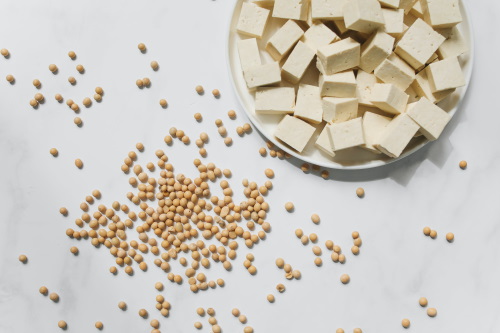Looking for a great plant-based high-protein food? Your first thought may be tofu or at least soybeans. Unfortunately, tofu—along with all other soy foods—has been the subject of some controversy. And, there are pros and cons of tofu in terms of taste and health benefits. The good news is that the pros appear to far outweigh the cons, and tofu is an affordable plant-based high-protein food, and with the right recipe, it can be pretty darn tasty, too.
What Is Tofu?
BREAKING: Viagra Obsolete: New Invention Cheaper, Safer, Faster
Tofu, or bean curd, is an ancient food created in Asia hundreds of years ago. And it’s one of the most popular plant-based proteins available. It can easily pitch hit for chicken, eggs, or meat in recipes, be the star of its own show (often in Asian dishes), or blend into various recipes. Because tofu has such a mild (some would even call it bland) taste and can absorb the flavors of the foods it’s cooked with, it’s also highly versatile.
Tofu can be found in soft (or silken), medium (or regular), firm, and extra-firm varieties. Each variety tends to be used a bit differently, and they all differ in their nutritional facts. For example, because it has a lower water content, firm tofu tends to have more calories, protein, carbs, and fat. Silken varieties have more water, so they tend to have the least number of calories and macronutrients.
No matter which tofu type you choose, the biggest claim to fame is that tofu is really high in protein for a plant-based food. It’s also low in fat, sodium, and carbohydrates with just .6 grams of net carbs (i.e., the total carbs minus the fiber, which is the amount of usable carbs in the food).
The nutrition breakdown for a half-cup serving of firm tofu is around:
- 181 calories
- 1 gram of fat
- 3.5 grams of carbs
- 2.9 grams of fiber
- And 21.8 grams of protein
Notably, tofu is a complete protein. That is, it provides all of the essential amino acids. Tofu is also nutrient-dense and a good source of calcium, manganese, copper, selenium, vitamin A, phosphorus, iron, magnesium, and zinc. One of the biggest pros and cons of tofu (and soybeans in general) is its high concentration of isoflavones, which are a phytoestrogen or plant-based estrogen-like compound.
Tofu is made by soaking soybeans and then cooking them and crushing them into a liquid. Often, a mineral-rich coagulant (typically nigari, which is made from sea water, or calcium) is then added to thicken the liquid that’s then pressed into solid blocks, similar to how cheese is made. An acid, such as lemon juice, can also be used in this process of coagulation. Tofu is naturally vegan and typically contains no dairy, gluten, or cholesterol as long as it isn’t pre-marinated.
Pros and Cons of Tofu
Because of the isoflavones found in tofu, it’s purported to have several benefits as well as drawbacks, such as:
-
Decreased risk of certain cancers as it may affect hormone levels. The research is still out on this subject. Yes, the soy isoflavones are similar to estrogen. However, they’re much, much weaker and have very different effects compared to synthetic estrogen.
Research on the isoflavones found in plants indicates they’re neutral, though they may help the body regulate natural estrogen levels. This could potentially help decrease the risk of some cancers. Some research even suggests eating soy foods after a breast cancer diagnosis is associated with a 25% decrease in tumor recurrence. Other research found people who ate more soy had a lower risk of death after a cancer diagnosis than those who never ate soy foods. 1 – 5 Yet other research found minimal, if any, reduced risk. 6
There has been some concern that the isoflavones in soy foods could increase the risk of cancer, especially in post-menopausal women. Fortunately, extensive research has found that concern is largely unfounded, and isoflavones don’t increase the risk of thyroid, breast, or uterine cancers. 7, 8
Other research indicates eating more soy foods like tofu may decrease the risk of endometrial, colon, stomach, lung, and prostate cancers. 9 – 13 For the most benefits, proponents recommend eating small servings of soy-containing foods more often. However, more research is certainly needed.
- Disruption of hormones again due to the estrogen-like isoflavones is one of the biggest concerns with regularly consuming tofu and other soy-containing foods. This is one of the biggest concerns by far. Some people have suggested that eating too much soy may even lower testosterone in men, disrupt thyroid function, or increase the risk of breast cancer.
Initial animal studies did find that consuming soy daily could impact hormone levels. However, there are big differences between laboratory mice and men. And, follow-up human studies found that soy wasn’t likely to affect hormones, including estrogen and testosterone (TT, FT, E2, or E1) in men. 14
Other research has found that soy foods do not appear to negatively affect breast cancer risks or thyroid health in healthy women. According to the Mayo Clinic, there’s no evidence that people with thyroid issues need to avoid soy foods. Other experts, however, suggest certain people should pay attention to soy intake, especially if they’re deficient in iodine, already have a thyroid dysfunction or disease, or have a history of breast cancer. 15, 16
- Decreased risk of heart disease according to one large U.S. study, which found that those who consumed tofu once a week had a moderately reduced risk of developing heart disease. 17 Tofu appears to help by lowering LDL (or the “bad” cholesterol) by up to four percent. 18 The isoflavones found in soy have also been associated with lowering blood pressure, which may support heart health. 19
- Increased exposure to genetically modified (GMO) crops as most of the soybeans used to make tofu are grown in the United States, and a large portion of them are genetically modified to resist pests, boost yield or nutrients, and make farming more efficient. Fortunately, for those who choose to limit exposure, it’s easy to simply choose organic tofu, which is GMO-free and still very reasonably priced.
- Reduced absorption of minerals like calcium, zinc, and iron (as well as protein) as it contains the “anti-nutrients” phytates and trypsin inhibitors. 20 These same anti-nutrients, however, have been found to improve carbohydrate metabolism, boost heart health, promote brain health, fight free radicals, and help eliminate heavy metals (like mercury, arsenic, and lead) from the body.
In addition, it’s been found that soaking, cooking, spouting, or fermenting soybeans lowers their anti-nutrient content. (Remember, tofu is made by soaking soybeans in water.) You can also find tofu made from sprouted soybeans, which may reduce phytates by up to 56% and trypsin inhibitors by a whopping 81% and increase protein content by about 13%. 21
There’s also some research indicating that consuming soy foods like tofu regularly may help those who have type 2 diabetes excrete less protein, 22 improve kidney function in those with kidney disease, 23 stave off bone loss in those with osteoporosis, especially after menopause, 24 and reduce menopause-related hot flashes. 25 Other research indicates it may help improve brain functions like memory, attention, and processing speed in some adults. 26
As you can see from the above examples, there are many more evidence-based pros than cons of tofu.
How to Prepare Tofu
The different types of tofu add to its versatility. Soft, silken, or medium tofu can be used to make puddings, custards, mousse, or added to smoothies or protein shakes to make them creamier or in pancakes, waffles, or “quiche” to replace eggs. It can also be “scrambled” similar to eggs or used to create a creamy sauce or dressing to go over noodles or salad instead of heavy cream (though it will need to be spiced up as tofu tastes pretty bland). Firm or extra firm tofu can crisp up and become almost “meat-like” in the oven or air fryer.
If the texture of tofu is your main deterrent to adding it to your diet, this simple, tasty recipe may change your mind.
TRENDING: Eat This - Never Forget A Single Thing Again
Air-Fried Tofu
Ingredients
- 1 block extra-firm tofu
- 3 tbsp coconut aminos (or low-sodium tamari)
- 1 tbsp rice wine vinegar
- 1 tbsp pure maple syrup
- 2 tsp sesame oil
- 1 clove garlic (or 1 tsp garlic powder)
- 1 tsp fresh or frozen ginger
- 1 tsp hot sauce of choice
- 1 tbsp arrowroot starch (or cornstarch)
Instructions
-
Open the tofu package and drain the liquid, gently pushing the excess water out with your hands, being careful not to crush or break the tofu.
-
Cut the block of tofu in half, and then cut each half into four somewhat equal strips. Then, cut again crosswise into ~1-inch cubes.
-
Line a plate, cutting board, or pan with a clean, lint-free towel to allow the tofu to continue to release liquid, gently pressing down on the tofu with another clean towel to remove as much water as possible.
-
Grab a large bowl and fill with the remaining ingredients. Stir to combine.
-
Toss in the drained tofu cubes and use your hands or a wooden spoon to cover the tofu with the marinade.
-
Allow to sit for at least 15 minutes, tossing 2 or 3 more times.
-
Preheat your air fryer to 400 degrees F.
-
Once warm, coat the air fryer tray with non-stick spray. Then, add a single layer of tofu cubes with space between each cube to allow the air to flow around. (This is what makes it nice and crispy). You may need to cook in a couple of different batches.
-
Cook each batch for 8 minutes and then shake the tray or gently turn the tofu with a spatula. Then replace the tray and continue to cook for between 2 and 6 minutes(depending on the air fryer), checking every minute or so until the tofu is golden brown and crispy.
-
Follow the same directions for the remaining tofu and discard any remaining marinade.
-
Enjoy!









